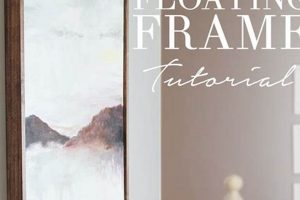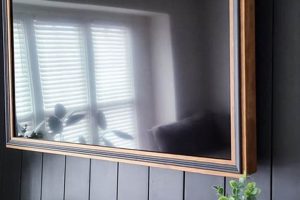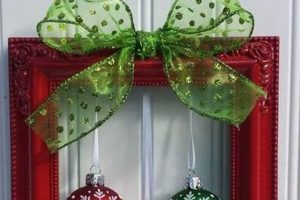A do-it-yourself framing package comprises the components and instructions necessary for an individual to construct a picture frame. Such a set typically includes pre-cut frame moldings, joining hardware, backing boards, and hanging apparatus. An illustrative example is a package containing four lengths of wooden molding with mitered edges, corner fasteners, a piece of foam core backing, and a sawtooth hanger.
The significance of this type of offering lies in its accessibility and customizability. It empowers consumers to create bespoke frames tailored to their specific artwork or photographs, offering a cost-effective alternative to professional framing services. Historically, individuals handcrafted frames from raw materials; the advent of pre-packaged sets democratized the process, making it easier for a broader audience to engage in this creative endeavor.
The subsequent sections will delve into various aspects of these offerings, examining the materials employed, the assembly techniques involved, the diverse styles available, and the considerations for selecting the appropriate option for a given project.
Essential Considerations for Utilizing a Do-It-Yourself Framing Package
The successful assembly of a picture frame from a pre-packaged set requires careful attention to detail. The following points provide guidance to ensure optimal results.
Tip 1: Accurate Measurement is Paramount. Prior to assembly, meticulously measure the artwork or photograph to be framed. Ensure the internal dimensions of the assembled frame correspond precisely to the item’s size to prevent slippage or an overly tight fit.
Tip 2: Miter Joint Precision is Crucial. The integrity of the frame relies on accurate mitered corners. Inspect the pre-cut angles to confirm a consistent 45-degree cut. Should imperfections exist, minor sanding may be necessary to achieve a seamless joint.
Tip 3: Secure Fastening Techniques are Essential. Employ appropriate fastening methods, such as corner clamps or specialized framing vices, to maintain alignment during assembly. Insufficient clamping pressure can lead to skewed corners and a structurally unsound frame.
Tip 4: Backing Board Selection Impacts Preservation. Opt for acid-free backing boards to safeguard the artwork from deterioration. Standard cardboard can leach acids over time, potentially damaging sensitive materials.
Tip 5: Hanging Hardware Placement Affects Stability. Position hanging hardware strategically to ensure the framed artwork hangs level. Consider the weight of the assembled frame when selecting the appropriate type of hanger. Heavier frames may necessitate multiple points of support.
Tip 6: Surface Protection Preserves Aesthetics. Apply a protective sealant or finish to the assembled frame to guard against scratches, dust, and moisture. Choose a finish that complements the frame’s material and the style of the artwork.
Adherence to these guidelines facilitates the creation of a professional-looking and durable picture frame, enhancing the presentation and preservation of valuable artwork or photographs.
The subsequent section will explore the variety of aesthetic styles and material options available within the realm of do-it-yourself framing packages.
1. Material Composition
The material composition of a do-it-yourself picture frame kit significantly impacts its aesthetic appeal, structural integrity, and suitability for various applications. Understanding the properties of different materials is essential for selecting a kit that aligns with both the intended artwork and the desired aesthetic.
- Wood: Traditional Elegance and Versatility
Wood offers a classic aesthetic and is readily customizable through staining, painting, or varnishing. Softwoods like pine are cost-effective but may be prone to dents and scratches. Hardwoods such as oak or maple provide superior durability but come at a higher price point. Consider a solid wood kit for heirloom photographs or fine art prints that warrant a timeless presentation. However, note wood’s susceptibility to moisture and humidity, which may warp the frame over time.
- Metal: Modern Minimalism and Strength
Metal frames, often constructed from aluminum or steel, offer a sleek, contemporary appearance. These materials are inherently resistant to moisture and offer excellent structural stability, making them suitable for environments with fluctuating humidity levels. Metal frames are typically joined using corner brackets and screws, ensuring a robust connection. They are well-suited for displaying modern art, graphic prints, or photographic works where a clean, understated frame is desired. The relative thermal conductivity of metal may necessitate considering its placement to minimize condensation risks.
- Polystyrene: Cost-Effective and Lightweight Alternative
Polystyrene, a synthetic polymer, provides a cost-effective and lightweight framing option. These frames are available in a wide array of colors and finishes, often mimicking the appearance of wood or metal. While polystyrene is resistant to moisture, it lacks the rigidity and durability of traditional materials. It is best suited for lightweight prints or posters and may not be appropriate for larger or more valuable artwork. The material’s susceptibility to scratching and fading under prolonged UV exposure should be considered.
- Composite Materials: Balancing Cost and Performance
Composite materials, such as medium-density fiberboard (MDF) wrapped with decorative paper or laminate, offer a balance between cost and performance. These frames are generally more rigid than polystyrene and can be finished to resemble wood or metal. However, MDF is susceptible to moisture damage and should not be used in humid environments. Composite frames are often used for mass-produced art prints or decorative items where cost is a primary concern.
In conclusion, the selection of a do-it-yourself picture frame kit necessitates careful consideration of the material composition and its inherent properties. Evaluating the artwork’s characteristics, the desired aesthetic, and the environmental conditions will ensure the chosen frame provides optimal protection and enhances the overall presentation. For instance, a valuable watercolor painting should be housed in a wood or metal frame with acid-free backing to prevent degradation, while a less valuable poster may be adequately displayed in a polystyrene or composite frame.
2. Joint Integrity
Joint integrity represents a foundational element within the realm of do-it-yourself picture frame kits. The strength and stability of the assembled frame directly correlate to the quality of the joints connecting its individual components. Inadequate joint integrity compromises the structural integrity of the frame, potentially leading to misalignment, warping, or even complete failure. This is particularly critical given the load-bearing role the frame assumes in supporting the artwork and any protective glazing.
Consider the scenario where a frame constructed from a kit with poorly mitered corners is assembled using insufficient adhesive. Over time, the stress exerted by the weight of the artwork will cause the corners to separate, resulting in visible gaps and a distorted appearance. Furthermore, an unstable frame jeopardizes the preservation of the artwork itself. Dust and environmental contaminants can infiltrate through weak joints, accelerating degradation. In contrast, a kit with precisely cut moldings and robust joining hardware, when assembled with proper technique, yields a frame that provides both aesthetic appeal and long-term protection for the enclosed artwork. For example, kits featuring pre-stressed corner clamps and high-strength wood glue ensure the joints remain secure under normal environmental conditions.
In summation, achieving optimal joint integrity is paramount when working with do-it-yourself picture frame kits. Selecting kits with high-quality components and employing meticulous assembly techniques are essential steps in creating a durable and visually pleasing frame. The importance of this element extends beyond mere aesthetics, safeguarding the artwork from potential damage and ensuring its long-term preservation. Overlooking the importance of joint integrity invites structural weaknesses and compromises the integrity of the entire framing process.
3. Dimensional Accuracy
Dimensional accuracy is a critical attribute of a do-it-yourself picture frame kit. Inaccurate dimensions in the kit’s components directly impact the frame’s ability to properly house and protect the artwork. For instance, if the internal dimensions of the assembled frame are smaller than the artwork, the artwork will be compressed, potentially causing damage, particularly to delicate media such as watercolor paper or photographs. Conversely, if the frame’s internal dimensions are excessively large, the artwork may shift within the frame, leading to aesthetic issues and increasing the risk of damage from friction or impact. Therefore, the precise measurement and cutting of frame moldings, backing boards, and any included glazing materials are essential for a successful outcome.
The implications of dimensional inaccuracies extend beyond simply fitting the artwork. The frame’s overall structural integrity is also compromised. Consider a kit where the mitered corners are not precisely cut to 45-degree angles. Upon assembly, this discrepancy will result in visible gaps at the corners, detracting from the frame’s aesthetic appeal and weakening the joints. This, in turn, can lead to warping or separation of the frame over time, especially when subjected to changes in temperature or humidity. Real-world examples abound where poorly dimensioned kits have resulted in artwork becoming dislodged from the frame, suffering irreparable damage.
In conclusion, the dimensional accuracy of a do-it-yourself picture frame kit is paramount to its functionality and the preservation of the artwork it is intended to protect. Any deviation from precise measurements can lead to aesthetic flaws, structural weaknesses, and potential damage to the artwork itself. Therefore, selecting a kit with demonstrably high dimensional accuracy and employing careful assembly techniques are crucial steps in achieving a satisfactory and enduring result.
4. Hanging Mechanisms
Hanging mechanisms are integral to the functional utility of a do-it-yourself picture frame kit. These components, typically consisting of D-rings, sawtooth hangers, wire, and screws, facilitate the secure and aesthetically pleasing display of framed artwork. An improperly selected or poorly installed hanging mechanism can precipitate catastrophic consequences, including the frame detaching from the wall, resulting in damage to the artwork and potential injury. The load-bearing capacity of the chosen mechanism must correspond to the weight of the assembled frame and its contents. For example, a lightweight print in a small polystyrene frame may be adequately supported by a single sawtooth hanger, while a larger, heavier framed oil painting necessitates the use of D-rings and picture wire secured directly to the frame’s side rails.
The selection of an appropriate hanging mechanism involves careful consideration of both the frame’s weight and the wall’s composition. Drywall, a common interior wall material, requires the use of specialized anchors to support heavier frames. Failure to employ such anchors can lead to the hanger pulling out of the wall, causing the frame to fall. In contrast, masonry walls necessitate the use of masonry screws and appropriately sized drill bits to ensure a secure attachment. Furthermore, the placement of hanging hardware on the frame influences its stability and levelness. D-rings should be positioned equidistant from the top edge of the frame to distribute the weight evenly and prevent tilting. Precise measurements and careful installation are paramount in achieving a professional and secure hanging outcome.
In conclusion, the seemingly simple element of hanging mechanisms plays a critical role in the overall success of a do-it-yourself picture frame project. A thorough understanding of weight distribution, wall composition, and hardware selection is essential for ensuring the safe and visually appealing display of framed artwork. Neglecting these considerations can lead to costly damage and potentially hazardous situations, underscoring the practical significance of properly implemented hanging mechanisms in the context of a do-it-yourself picture frame kit.
5. Aesthetic Versatility
Aesthetic versatility constitutes a fundamental attribute of a do-it-yourself picture frame kit, enabling the adaptation of the frame’s appearance to complement the artwork it houses, as well as the surrounding decor. The inherent flexibility of these kits allows for customization through a range of finishes, colors, and stylistic choices, providing an alternative to the constraints of pre-fabricated frames. This adaptability is crucial because a frame that clashes with the artwork or its environment diminishes the overall visual impact. A stark, modern photograph, for instance, may be enhanced by a minimalist metal frame from a kit, while a traditional oil painting may benefit from a more ornate, gilded wooden frame similarly sourced. The cause and effect is direct: the greater the aesthetic versatility of the kit, the more effectively it can enhance the artwork’s presentation.
The practical significance of aesthetic versatility is realized in its ability to cater to diverse artistic expressions and interior design preferences. Consider a scenario where an individual collects both antique maps and contemporary digital art. A series of do-it-yourself kits, each tailored to a specific aesthetic one offering distressed wood finishes for the maps and another providing sleek, black metal options for the digital art allows for a cohesive presentation despite the disparate styles of the artwork. Furthermore, this versatility extends to enabling users to modify existing frames from kits to adapt to changing decor trends or personal tastes. A previously dark-stained frame, for example, can be repainted in a lighter color to better suit a newly renovated room, demonstrating the ongoing adaptability afforded by these kits.
In summary, aesthetic versatility is not merely a superficial feature of a do-it-yourself picture frame kit; it is a key component that empowers individuals to curate personalized displays of their artwork. Challenges in achieving this versatility may include the need for acquired skills in finishing techniques, but the benefits of enhanced artistic presentation and alignment with personal aesthetics far outweigh these challenges. Understanding and leveraging aesthetic versatility allows for the creation of visually harmonious and impactful displays, ultimately elevating the appreciation and preservation of the artwork itself.
Frequently Asked Questions
The following section addresses common inquiries regarding do-it-yourself picture frame kits, providing comprehensive and objective answers to ensure informed decision-making.
Question 1: What tools are typically required to assemble a DIY picture frame kit?
Standard tools include a miter saw or miter box with a saw, wood glue or suitable adhesive, clamps (corner clamps are recommended), a measuring tape, a pencil, and potentially a brad nailer or staple gun for securing the backing board. Specific kits may necessitate additional tools as outlined in the accompanying instructions.
Question 2: How can the correct size of the picture frame kit be determined for specific artwork?
Precise measurement of the artwork (length and width) is crucial. Select a kit where the listed internal dimensions of the assembled frame precisely match or slightly exceed the artwork’s dimensions. An allowance of 1/8″ to 1/4″ larger than the artwork allows for easier insertion and prevents compression.
Question 3: What are the primary differences between wooden and metal DIY picture frame kits?
Wooden kits offer a traditional aesthetic and are customizable via staining or painting. Metal kits provide a modern, minimalist appearance and superior durability, particularly in humid environments. Wooden frames are generally more susceptible to warping and moisture damage compared to metal frames.
Question 4: What type of backing board is recommended for use in a DIY picture frame kit?
Acid-free foam core or archival-quality mat board is highly recommended. These materials prevent the leaching of acids that can damage artwork over time. Standard cardboard should be avoided due to its acidic composition.
Question 5: How can mitered corners be ensured to be aligned properly during frame assembly?
The use of corner clamps or a framing vise is essential to maintain accurate alignment while the adhesive sets. Apply even pressure to all four corners to prevent gaps or uneven joints. Dry-fitting the corners before applying adhesive can also help identify and correct any misalignments.
Question 6: How is artwork secured within a DIY picture frame once assembled?
Artwork is typically secured using flexible tabs, brad nails, or staples along the inside edge of the frame. Ensure the backing board is flush against the artwork to prevent movement. If using brad nails or staples, exercise caution to avoid damaging the artwork.
In conclusion, selecting and assembling a do-it-yourself picture frame kit requires careful attention to detail and adherence to proper techniques. Addressing the considerations outlined above promotes a successful framing outcome and ensures the long-term preservation of valuable artwork.
The subsequent section will provide a detailed comparison of various DIY picture frame kit brands, offering insights into their respective strengths and weaknesses.
Conclusion
This exploration has illuminated the multifaceted nature of the “diy picture frame kit,” emphasizing its components, assembly considerations, material diversity, and impact on both aesthetic presentation and archival preservation. The inherent versatility of these kits, from material selection to hanging mechanisms, underscores their capacity to meet a spectrum of artistic and practical needs. Dimensional accuracy and joint integrity were identified as critical factors influencing structural stability and artwork protection. The careful selection and assembly of a picture frame kit, therefore, constitutes a deliberate act of curatorial stewardship.
Given the enduring value of visual art and photographic documentation, the capacity to frame and display these items with precision and personal style remains significant. The “diy picture frame kit,” when approached with informed understanding and meticulous execution, offers a pathway to achieve this goal, ensuring that cherished pieces are not only showcased effectively but also preserved for future appreciation. The continued refinement of kit designs and assembly techniques promises even greater accessibility and artistic control in the realm of self-directed framing.







